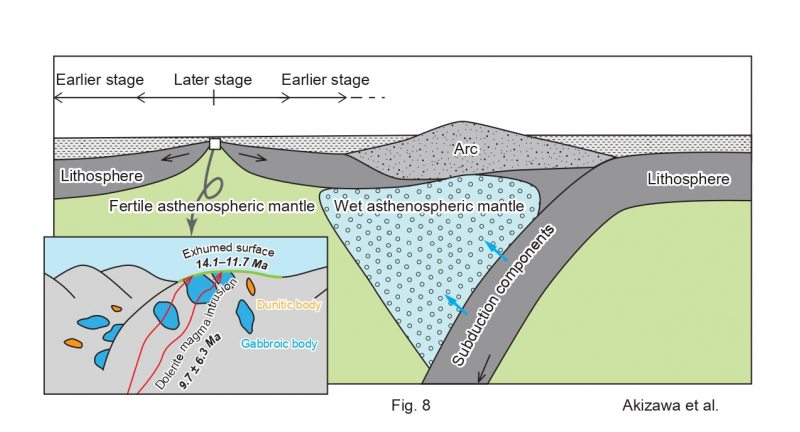
Late dry back-arc magmatism recorded as dolerite dike intrusion in the Mado Megamullion, Shikoku Basin
ABSTRACT

Back-arc basins (BABs) form an integral but often neglected part in the framework of subduction zone system. Many studies on the BAB have focused on BAB basalts because they are more accessible than to the lower crust and underlying mantle. The Shikoku and Parece Vela Basins formed behind arc systems in the Philippine Sea host numerous oceanic core complexes (OCCs), dome-like bathymetric highs composed of lower crust and mantle materials. One of these OCCs named Mado Megamullion is the study target emplaced in the Shikoku Basin, where dolerite dike intrusions are recognized as a late back-arc magma activity. Ilmenite U–Pb dating of a dolerite sample revealed that the dolerite formed at 9.7 ± 6.3 Ma (2 sigma error, n = 24), at which the Shikoku Basin ceased spreading. Geochemical tracers of Ba/Yb, Ba/Nb, and Th/Nb were used to evaluate the extent of subduction input to dolerite-forming magmas. The results demonstrated that the subduction components did not reach the back-arc spreading center and hence the dolerite-forming magma was dry as the back-arc spreading center was well apart from the fluid-supplying slab when the Mado Megamullion was formed. The Mado Megamullion has ample potential to decode mature back-arc spreading system, whereas the OCCs located in initial spreading modes of the Shikoku Basin can decipher immature back-arc spreading system. Accurate understanding of BAB evolution will come from further investigations of time-dependent emplacements of OCCs in the Shikoku and Parece Vela BABs.
KEYWORDS
Keywords: ilmenite U–Pb dating, zircon, back-arc basin, oceanic core complex, mantle- Published : 2024
- Released on J-STAGE : 2024/09/27
- Received : 2024/02/10
- Accepted : 2024/08/03
- DOI : https://doi.org/10.2343/geochemj.GJ24016
- J-STAGE URL : https://www.jstage.jst.go.jp/article/geochemj/58/5/58_GJ24016/_article/-char/en
- J-Online ISSN: 1880-5973
- Print ISSN : 0016-7002
- ISSN-L : 0016-7002
All Issues
- Vol.59, 2025
- Vol.58, 2024
- Vol.57, 2023
- Vol.56, 2022
- Vol.55, 2021
- Vol.54, 2020
- Vol.53, 2019
- Vol.52, 2018
- Vol.51, 2017
- Vol.50, 2016
- Vol.49, 2015
- Vol.48, 2014
- Vol.47, 2013
- Vol.46, 2012
- Vol.45, 2011
- Vol.44, 2010
- Vol.43, 2009
- Vol.42, 2008
- Vol.41, 2007
- Vol.40, 2006
- Vol.39, 2005
- Vol.38, 2004
- Vol.37, 2003
- Vol.36, 2002
- Vol.35, 2001
- Vol.34, 2000
- Vol.33, 1999
- Vol.32, 1998
- Vol.31, 1997
- Vol.30, 1996
- Vol.29, 1995
- Vol.28, 1994
- Vol.27, 1993
- Vol.26, 1992
- Vol.25, 1991
- Vol.24, 1990
- Vol.23, 1989
- Vol.22, 1988
- Vol.21, 1987
- Vol.20, 1986
- Vol.19, 1985-1986
- Vol.18, 1984
- Vol.17, 1983
- Vol.16, 1982
- Vol.15, 1981
- Vol.14, 1980
- Vol.13, 1979
- Vol.12, 1978
- Vol.11, 1977
- Vol.10, 1976
- Vol.9, 1975
- Vol.8, 1974
- Vol.7, 1973
- Vol.6, 1972-1973
- Vol.5, 1971
- Vol.4, 1970-1971
- Vol.3, 1969-1970
- Vol.2, 1968
- Vol.1, 1966-1967




